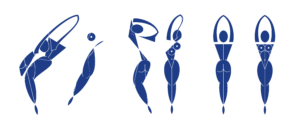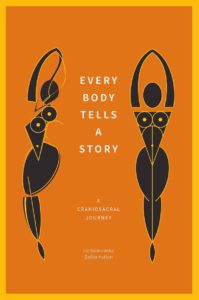
by Liz Kalinowska and Daška Hatton
A feminine approach to therapeutic bodywork has interested me since I took my first tentative steps along this path sometime in the mid 1990’s. I noticed that in my field (Alexander Technique / Craniosacral Therapy) most of the practitioners are women and yet most of the courses and books on the subject are written by men. The feminine viewpoint is and always has been different, with a distinctive voice and function. Although a massive over-simplification, the masculine approach tends to focus on techniques and results, while the feminine may naturally relate more intuitively and compassionately.
Our culture has been one history of suppression and overthrow of the feminine perspective by the logic orientated and focused consciousness of the male. A woman’s diffuse and compassionate awareness can be overpowered by the harsh and penetrating searchlight of the male intellect. This is unbalanced and is reflected in all areas of our society. As we all know, focused consciousness is indispensable, but we are equally aware that the rational approach is not the only answer to the problems that we may face in our lives. This is not an attempt to supplant the masculine with the feminine, but to redress that balance.
Rather than a manual of techniques and protocols, our book, Every Body Tells a Story, is more a lyrical attempt to discover and illustrate this feminine approach to healing and how it might differ from that of the masculine. It is not trying to argue for one approach over another. It is rather a plea to see the whole picture and to connect not only the masculine and the feminine, the mind and the body, but also to begin to have a sense of ourselves as part of something larger than our own stories, as part of life.
We look at the myths and the archetypal portrayals of the female and try to link these ancient stories to our very real sense of our bodies and ourselves as we experience them in the present. My lifelong interest and reading of mythology has helped immeasurably. Over the years I have understood and related to the myths in different ways, their meanings have changed and shifted and I see beyond to yet another layer. The myths enable us to see dark periods of life as invested with meaning rather than as random chemical disturbances in the brain. It can be helpful to see the larger picture, to see how those who have gone before have approached this junction or transition in their lives and this is where the myths come in.

One of the most reassuring things that I find reading the myths is this sense that in contrast to our ego driven obsessions in the 21st century, misfortunes and breakdowns are perceived as a result of the activities of Gods. Man is simply not “the measure of all things”. The mythological viewpoint shows us a world of cause and effect outside our own personal concerns. It mitigates the fear of chaos and meaninglessness to read of these passages through darkness. Of course today, with our logic and reason and ego, we ascribe any illness or disease to medical causes. It is simply another belief structure; I am not saying that it is not true, merely that it is not the only truth.
“We think we can congratulate ourselves… imagining that we have left behind all these phantasmal gods far behind. But what we have left behind are only verbal spectres, not the psychic facts that were responsible for the birth of the gods. We are still as much possessed by autonomous psychic contents as if they were Olympians. Today they are called phobias, obsessions, and so forth; in a word, neurotic symptoms. The gods have become diseases, Zeus no longer rules Olympus but rather the solar plexus, and produces curious symptoms for the doctor’s consulting room …” – CG Jung Commentary in The Secret of the Golden Flower
The word healing literally means to “make whole”. Here, we look at healing in the widest possible sense. Not only to cure, but to rebalance, to reconcile the opposites, and to allow mutually exclusive truths to exist at the same time. Part of the feminine approach to healing is perhaps to ask the restoring and compassionate question “What ails thee?”, and, to be able to listen to the answer. In the myth of Parsifal it is the expression of this very question that was all that was needed to heal the Fisher King and to restore the waste land of his kingdom. As in the myth there are wounds that exist on the different planes of our mental, emotional, spiritual, and physical lives. We suffer in our society because of a disconnection between these different levels, and between the masculine and feminine values and attributes.
We are never just our thoughts, or our feelings or our sensations, but a fluctuating combination of all of these and more at the same time. The more that we can connect to these different levels in ourselves, the more we can “Live in fragments no longer”. We use the same word ‘feeling’ to describe both our emotions as well as physical sensations. Why? Another answer could be that because they are so intimately connected, emotions “are inseparable from the body in which they are felt”; another answer could be a reflection of the importance we give to either of these two states, they are not considered worthy of differentation. What do those well-known feelings that we shy away from really feel like in the body? What happens when, for perhaps the first time, we turn towards the sensations with interest instead of tightening and recoiling? This is no small-thing; it is what attracted me to subsequently train to become a Craniosacral Therapist. Never had I experienced such calmness.
It is not claimed that bodywork is a universal panacea for every kind of ailment. It is simply that our feelings and emotions are so intimately connected with our behavioural and psychological habits that working in this way can be part of the healing process, it may not be the whole part, but it IS a part. By being quiet enough to observe the feelings of the body without connecting them to the convictions that accompany them, not using the brain but the senses, we can start to discover what the body is telling us. Only you can know what your body is feeling, we cannot know what anyone else really feels. My main job as a bodywork therapist is to provide the conditions of stillness and quietness that aid the process of perceiving what is really there. Sometimes, just bringing those feeling states into awareness allows them to be heard, allows them to dissipate. It is just such a journey of discovery that we illustrate in our book.
Liz Kalinowska and Daška Hatton are the authors of Every Body Tells a Story: A Craniosacral Journey.
To find out more, or purchase a copy for yourself, please visit intl.singingdragon.com.
